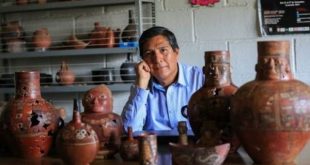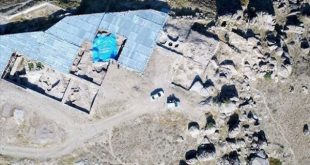 Scientists have found a temple of Mithras.
Scientists have found a temple of Mithras.
Events unfolded according to a standard European scenario: in Corsica decided to build a new road, called archaeologists, without which it is impossible to obtain a building permit.
Researchers have unearthed the specified site and found the ruins of “unclear morphology”, as expressed by local newspaper Corse Net Infos. In other words, the ruins of a similar shape Corsican archaeologists have not yet met. The process of identification, however, was short, and the result is sensational: in Corsica for the first time found mithraeum, that is, the temple of Mithras.
“Find stunning and extremely rare. We did not know that Corsica was practiced Mithraism. Earlier in continental France have been found the sanctuary of Mithras, there are about a dozen of them. The latter was discovered during excavations in Angers in 2010”, — told IBTimes UK the head of the excavation Chapon Philippe (Philippe Chapon).
In the territories once controlled by the Roman Empire, archaeologists found a total of about a hundred shrines of Mithras, the most famous located in the heart of the Empire – in Rome and Ostia. The cult of Mithras, a deity of Indo-Iranian origin, had penetrated into the Roman Empire in the late first century: the main “distributors” was the Roman soldiers and traders from the East.
A couple of centuries, Mithraism was the main competitor to the other new religion, Christianity. Like the first Christians, followers of the cult of Mithras was subjected to persecution and brutal repression, but the rest of the story is known: Mithraism, along with other “pagan” cults, was finally banned by Emperor Theodosius I in 392 ad, Christianity became a state religion. For modern scholars of Mithraism remains a very mysterious phenomenon in the first place because of information about it almost did not survive. Historians have counted more than 60 references to Mithra and Mithraism, the Greek and Roman authors (not counting Armenian and Persian), but the anecdotal information give a not too clear picture.
“We know very little about the cult of Mithras. In the absence of direct written sources most of our knowledge about this ancient monotheistic religion based on the study of the ruins of the temples of Mithra and those of the images that are there,” says Philip Sapon.
Corsican sanctuary of Mithras occurred in the open field: the ruins are located near the coast of the island, on the outskirts of well-known historians of Roman settlement Mariana. In terms of modern geography is a commune Lucciana (Department of Upper Corsica), the area near the airport Bastia-Poretta.
In the vicinity of the site is the famous La Canonica Cathedral of the XII century. According to Seneca and Pliny the Elder, a Roman colony of Mariana, founded around 100 BC, the famous military leader, the powerful Consul and army reformer Gaius Marius (Caius Marius). Gaius Marius was considered a colonization of Corsica as part of the Roman military strategy at sea. However, Marian never became a major seaport in its heyday in the III or IV centuries, the settlement size does not exceed 10 hectares.
“During the Roman domination, Corsica was poorly urbanized. We are aware of only two relatively major Roman settlement: Mariana and Aleria. Interestingly, the area on the outskirts of Mariana, where we are currently conducting excavations of the later is not settled, neither in the Middle ages or in our time. We have received a “time capsule” in good condition, not modified later layers,” says Daniel Istria (Istria Daniel), the head of several archaeological expeditions in Corsica.
However, its local role, a colony was performed: in Mariana found a lot of artifacts indicating an active trade with the Roman Corsica, Sardinia and Tuscany. It seems that trade created opportunities for the penetration of Mithraism to Corsica. And yet, surprisingly, in the small settlement of “accumulated” enough followers of Mithras to build a large sanctuary in the first century of our era. The architecture of mitreola in Mariana does not differ almost from a device other well-known temples of Mithras.
In addition to the sanctuary, archaeologists have discovered several rooms, including a refectory hall with a Central passageway along which were two large, almost two meters in width, pews for the faithful – people could comfortably be placed on them during the General meetings, prayers and meals. In the depths of the Central aisle was the image of Mithras killing a sacred bull (the canonical scene in modern science called “tauroctony”). The form of this image could be fresco, bas-relief or a sculpture.
To Marianske mitrione archaeologists have discovered a marble bas-relief, or rather, three fragments, preserved after the destruction of the temple. The marble fragments archaeologists saw the lower part of the miter in a tunic (hence the missing head was a Phrygian cap is the canonical dress of the deity), as well as parts of the sacred bull and other required elements of this scene: the snake and the dog is directed to the jet of blood flowing from the wound on the neck of the bull, and the Scorpion, claws clutching the genitalia of the bull.
In addition to Mithra, the archeologists discovered fragments of the other characters: the female marble head and an image of one of the two torchbearers of Mithras, in this case Cautopates, the man lowered a torch, symbolizing the setting sun and death. Among other finds are two bronze bells, a lot of broken lamps (all the sanctuaries of Mithra were located underground), vessels of the quality of the clay, perhaps used during worship services, as well as two plates of bronze and lead. On the plates you can see the inscription yet to be deciphered.
Shortly after the announcement of the discovery of mitreola archaeologists added the list of the detected artifacts of the glove is a typical part of the outfit of a Roman soldier. Excavations have revealed evidence of deliberate destruction of the temple of Mithras – the history of the competition two religions, Mithraism and Christianity, in Mariana presented very clearly: the bas-reliefs broken in antiquity, the temple destroyed almost to the ground and filled with small stones. Scientists are not yet ready to make definite conclusions, but note that about 400 years in Mariana was erected a large Christian complex with a Basilica and a baptistery, the most ancient sign of the establishment of Christianity in Corsica.
Excavations of mitreola will last until the end of March, then the archaeologists will now study finds. Experts still should develop a plan for the preservation of ancient ruins that are in the zone of constant flooding. All the excavated artifacts will be exhibited in the Museum of the commune Lucciana – the future of the Museum, which is also yet to be created.
© 2017, paradox. All rights reserved.




